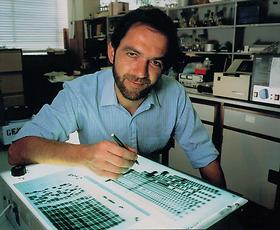Cases
Alec Jeffreys and the Pitchfork murder case: the origins of DNA profiling
British geneticist Alec Jeffreys began working in 1977 on a technique that could identify individuals through samples of their DNA. In 1984, he and colleagues devised a way to use a newly discovered property of DNA, isolated areas of great variability between individuals called restriction fragment length polymorphisms (RFLP), for forensic identification—the original DNA fingerprint.
In 1986, police asked Jeffreys for help in finding a man who had raped and killed two girls. DNA tests exonerated the primary suspect. Through a genetic dragnet, police found the perpetrator, Colin Pitchfork, who gave himself away when he asked a friend for a substitute blood sample.
Within a year, genetic fingerprinting was making the unique molecular structures of victims and suspects visible in criminal investigations around the world. Today, RFLP-based DNA analysis is being supplanted by newer techniques of genetic identification.
